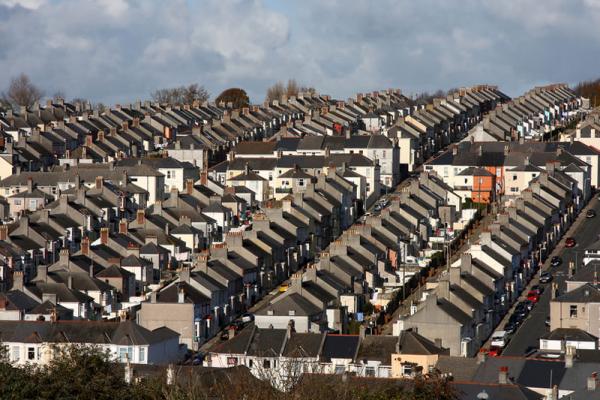GMB call for more robust tax regime to reduce vacant properties in London

GMB call for a more robust tax regime to reduce the 59,881 vacant properties in London.
Many, many more of these purposefully unoccupied dwellings must be utilised more thoroughly and for that to happen there needs to be a punitive tax regime put in place says GMB London.
There are over 59,881 vacant properties in London, over a third of which, 20,915, have been vacant for more than 6 months. In England as a whole there are 600,179 vacant dwellings, 203,596 of which have been empty for more than 6 months.
In Southwark there are 4,677 vacant dwellings, the London borough with the highest number. Next highest is Ealing with 3,209 vacant dwellings, Croydon with 3,130, Islington with 2,981, Bromley with 2,751, Barnet with 2,638 and Camden with 2,617.
The current tax regime differs significantly depending on where the vacant property is located. Councils can either offer a discount for a second home or an empty property or they can charge extra for empty properties, up to 50% on top of the full charge, if the property has been empty for 2 years or more.
The number of empty properties leads to fewer properties available and higher rents due to the increase in demand. See notes for GMB press release last month on average earnings and rents.
Set out in the table below are the 2015 figures for all 33 London boroughs. The table has been compiled by GMB London region using official data from the Department for Communities and Local Government, see notes to editors for sources and definitions.
| rank | All vacant dwellings - October 2015 | |
| 1 | Southwark | 4,677 |
| 2 | Ealing | 3,209 |
| 3 | Croydon | 3,130 |
| 4 | Islington | 2,981 |
| 5 | Bromley | 2,751 |
| 6 | Barnet | 2,638 |
| 7 | Camden | 2,617 |
| 8 | Haringey | 2,397 |
| 9 | Hackney | 2,268 |
| 10 | Kensington and Chelsea | 2,145 |
| 11 | Lewisham | 2,131 |
| 12 | Newham | 2,025 |
| 13 | Lambeth | 1,980 |
| 14 | Enfield | 1,907 |
| 15 | Tower Hamlets | 1,844 |
| 16 | Sutton | 1,799 |
| 17 | Greenwich | 1,796 |
| 18 | Hillingdon | 1,399 |
| 19 | Havering | 1,352 |
| 20 | Wandsworth | 1,309 |
| 21 | Redbridge | 1,293 |
| 22 | Westminster | 1,255 |
| 23 | Merton | 1,249 |
| 24 | Kingston upon Thames | 1,206 |
| 25 | Bexley | 1,180 |
| 26 | Barking and Dagenham | 1,154 |
| 27 | Waltham Forest | 1,143 |
| 28 | Richmond upon Thames | 1,136 |
| 29 | Hounslow | 1,095 |
| 30 | Brent | 1,073 |
| 31 | Hammersmith and Fulham | 831 |
| 32 | Harrow | 825 |
| 33 | City of London | 86 |
Warren Kenny, GMB London regional secretary, said, “It is abundantly clear that the current tax regime is not working and a more robust structure is needed. Even if the full 50% extra charge in council tax is levied, this is not a deterrent to the wealthiest investors.
Many, many more of these 60,000 purposefully unoccupied dwellings in London must be utilised more thoroughly. These empty properties can be used and transformed into homes for people and families desperately in need of decent and affordable housing. For that to happen there needs to be a punitive tax regime put in place.
The decisions of the Thatcher government in the 1980’s to sell council housing stock, and not replace it, and to pay landlords housing benefit instead of providing social housing directly has been a huge and expensive mistake.
Last year, for example, £24 billion was spent on housing benefit, with much of this public money ending up untaxed in bank accounts in offshore tax havens. If a fraction of that amount had been spent on social housing for rent, the strain on the tax payer would be less and people would have housing they can afford to live in.
The situation will only get worse next year when the Housing and Planning Act comes into force in April 2017 which will force councils to sell off high value council properties when they become empty. Selling social housing, at a time of dire shortages of homes for rent at affordable prices, is scandalous and irresponsible madness.
“Patrik Schumacher, director and principal of Zaha Hadid Architects, one of the multi-millionaire elite has called for council housing in London to be cleared, affordable housing to be abolished and for Londoners to celebrate empty properties as well as suggesting Hyde Park be built over.
He is advocating social Darwinism which the vast majority of Londoners will reject. It is absolutely disgusting that the elite have so little regard for ordinary Londoners.
Mr Schumacher’s ridiculous, extremist and fanatical opinions should be treated with the utter contempt that such fantasist views deserve.”
End
Contact: Warren Kenny on 07843 632394; Tony Warr 07710 631336; Richard O'Leary 07710 631347; Dave Powell 07710 631349 or Keith Williams 07710 631339
Notes to Editors:
1 Source: Table 615 All vacant dwellings by local authority district, Department for Communities and Local Government
2 A dwelling is a single self-contained household space or two or more household spaces at the same address that are not self-contained but combine to form a shared dwelling that is self-contained.
3 Section 3.14D of the London Plan states: ‘Boroughs should promote efficient use of the existing stock by reducing the number of vacant, unfit and unsatisfactory dwellings, including through setting and monitoring targets for bringing properties back into use. In particular, boroughs should prioritise long-term empty homes, derelict empty homes and listed buildings to be brought back into residential use.’
4 GMB Press release 24 October 2016
AVERAGE RENTS FOR A TWO BEDROOM PROPERTY RISE TO OVER HALF OF AVERAGE PAY IN 16 LONDON BOROUGHS NEW GMB STUDY SHOWS
A massive programme to build more homes is absolutely essential and has to get underway without delay says GMB
The average rents for two bedroom apartments has risen to more than 50% of gross average earnings of residents in 16 London Boroughs.
In Westminster the average rent for a two bedroom property is 73% of the gross average earnings of residents of the borough. This is the highest in London.
Next highest are 67% in Hackney, 66% in Islington, 63% in Camden, 60% in Brent, Tower Hamlets and Ealing, 58% in Haringey and Lambeth and 57% in Newham.
In London as a whole, workers are paying out over 54% of their earnings on rent, up from 45% in 2011. This is significantly higher than the England average figure of 26%.
Set out in the table below are the 2016 figures for 30 London boroughs where data are available with comparable figures for 2011 for a two bedroom property. Set out in notes to editors are the figures for a one and three bedroom properties.
The tables have been compiled by GMB London region, see notes to editors for sources and definitions.
| 2011 median rent | 2011 median monthly earnings | % | 2016 median rent | 2015 median monthly earnings | % | ||
| rank | London | 1,192 | 2,654 | 44.9 | 1,500 | 2,767 | 54.2 |
| 1 | Westminster | 2,275 | 3,485 | 65.3 | 2,600 | 3,567 | 72.9 |
| 2 | Hackney | 1,343 | 2,670 | 50.3 | 1,798 | 2,683 | 67.0 |
| 3 | Islington | 1,625 | 3,020 | 53.8 | 1,950 | 2,956 | 66.0 |
| 4 | Camden | 1,733 | 2,926 | 59.2 | 2,080 | 3,301 | 63.0 |
| 5 | Brent | 1,300 | 2,234 | 58.2 | 1,500 | 2,481 | 60.4 |
| 6 | Tower Hamlets | 1,430 | 2,817 | 50.8 | 1,750 | 2,904 | 60.3 |
| 7 | Ealing | 1,100 | 2,531 | 43.5 | 1,452 | 2,415 | 60.1 |
| 8 | Haringey | 1,213 | 2,534 | 47.9 | 1,495 | 2,578 | 58.0 |
| 9 | Lambeth | 1,235 | 2,840 | 43.5 | 1,600 | 2,778 | 57.6 |
| 10 | Newham | 950 | 2,207 | 43.0 | 1,300 | 2,265 | 57.4 |
| 11 | Hammersmith and Fulham | 1,495 | 2,924 | 51.1 | 1,798 | 3,169 | 56.7 |
| 12 | Southwark | 1,300 | 2,778 | 46.8 | 1,560 | 2,878 | 54.2 |
| 13 | Merton | 1,100 | 2,753 | 40.0 | 1,425 | 2,760 | 51.6 |
| 14 | Wandsworth | 1,387 | 3,051 | 45.5 | 1,700 | 3,297 | 51.6 |
| 15 | Waltham Forest | 910 | 2,251 | 40.4 | 1,250 | 2,461 | 50.8 |
| 16 | Barnet | 1,127 | 2,708 | 41.6 | 1,400 | 2,757 | 50.8 |
| 17 | Lewisham | 950 | 2,444 | 38.9 | 1,300 | 2,649 | 49.1 |
| 18 | Greenwich | 900 | 2,550 | 35.3 | 1,290 | 2,646 | 48.7 |
| 19 | Enfield | 1,000 | 2,420 | 41.3 | 1,250 | 2,591 | 48.2 |
| 20 | Harrow | 975 | 2,584 | 37.7 | 1,295 | 2,711 | 47.8 |
| 21 | Richmond upon Thames | 1,275 | 3,428 | 37.2 | 1,550 | 3,297 | 47.0 |
| 22 | Barking and Dagenham | 825 | 2,160 | 38.2 | 1,100 | 2,369 | 46.4 |
| 23 | Kingston upon Thames | 1,068 | 2,908 | 36.7 | 1,350 | 3,064 | 44.1 |
| 24 | Sutton | 850 | 2,447 | 34.7 | 1,150 | 2,616 | 44.0 |
| 25 | Hillingdon | 925 | 2,561 | 36.1 | 1,200 | 2,749 | 43.7 |
| 26 | Croydon | 850 | 2,522 | 33.7 | 1,150 | 2,741 | 42.0 |
| 27 | Redbridge | 900 | 2,684 | 33.5 | 1,200 | 2,972 | 40.4 |
| 28 | Bromley | 900 | 2,843 | 31.7 | 1,200 | 3,042 | 39.5 |
| 29 | Bexley | 795 | 2,670 | 29.8 | 1,000 | 2,670 | 37.5 |
| 30 | Havering | 825 | 2,516 | 32.8 | 1,000 | 2,690 | 37.2 |
Warren Kenny, GMB London regional secretary, said, “These figures demonstrate the extent of the squeeze felt by workers and their families in London since the financial crisis in 2008. Rents have surged upwards as pay has been stagnant or falling.
They show that a massive programme to build more homes, especially homes for rent, by the London boroughs is absolutely essential in all parts of the region and has to get underway without delay.
We have been talking about this problem for far too long, there can be no excuses for not providing housing to people that they can afford to live in on average wages.
The decisions of the Thatcher government in the 1980’s to sell council housing stock, and not replace it, and to pay landlords housing benefit instead of providing social housing directly has been a huge and expensive mistake.
Last year, for example, £24 billion was spent on housing benefit, with much of this public money ending up untaxed in bank accounts in offshore tax havens. If a fraction of that amount had been spent on social housing for rent, the strain on the tax payer would be less and people would have housing they can afford to live in.
These mistakes need to be corrected without delay, fair and affordable housing is a basic aspiration for all.”
End
Contact: Warren Kenny on 07843 632394; Tony Warr 07710 631336; Richard O'Leary 07710 631347; Dave Powell 07710 631349 or Keith Williams 07710 631339
Notes to Editors:
1 Source: Private Rental Market Summary Statistics; Valuation Office Agency © Crown copyright 2016.
The data is collected by the Valuation Office for the purpose of supporting the Local Housing Allowance – used to work out how much Housing Benefit is paid if renting from a private landlord. This is the primary purpose of the data and as a result the samples from year to year can vary so the data provides a snapshot on the market rather than a comprehensive study of all prices. The data used to generate these statistics are based on a sample of rental information, collected by Rent Officers from landlords and letting agents.
One Bedroom self-contained properties with one bedroom including houses, bungalows, flats and maisonettes.
Two Bedrooms self-contained properties with two bedrooms including houses, bungalows, flats and maisonettes.
Three Bedrooms self-contained properties with three bedrooms including houses, bungalows, flats and maisonettes.
2 Earnings data is from the Annual Survey of Hours and Earnings 2011 and 2015, Office for National Statistics. Data is for gross median annual pay for all full time employees by place of residence.
3 Table showing proportion of median rent to median earnings of full-time workers for 1 and 3 bedroom properties
| 2016 proportion of average rent to average earnings | ||
| 1 bedroom | 3 bedrooms | |
| London | 45.2 | 65.1 |
| Westminster | 54.7 | 108.7 |
| Hackney | 53.3 | 88.8 |
| Islington | 51.3 | 82.8 |
| Ealing | 49.7 | 74.5 |
| Tower Hamlets | 49.2 | 76.1 |
| Brent | 48.4 | 73.3 |
| Lambeth | 48.3 | 78.0 |
| Camden | 47.9 | 88.6 |
| Haringey | 47.9 | 72.9 |
| Newham | 46.4 | 70.7 |
| Southwark | 44.4 | 66.0 |
| Hammersmith and Fulham | 43.6 | 80.3 |
| Merton | 42.6 | 65.2 |
| Wandsworth | 42.1 | 67.5 |
| Waltham Forest | 40.6 | 61.0 |
| Barnet | 39.9 | 65.3 |
| Greenwich | 39.7 | 54.3 |
| Lewisham | 39.6 | 60.4 |
| Harrow | 36.9 | 59.0 |
| Enfield | 36.7 | 57.9 |
| Richmond upon Thames | 36.4 | 63.6 |
| Barking and Dagenham | 35.9 | 54.9 |
| Kingston upon Thames | 34.9 | 56.6 |
| Sutton | 33.5 | 55.4 |
| Hillingdon | 32.7 | 52.7 |
| Croydon | 31.9 | 49.3 |
| Redbridge | 30.3 | 50.5 |
| Havering | 29.7 | 46.5 |
| Bromley | 29.6 | 47.7 |
| Bexley | 28.1 | 46.8 |


